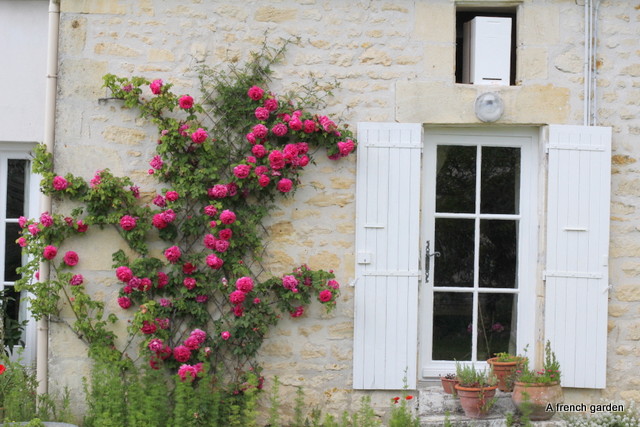
This is the time for the first and best bloom of the roses. The climbing rose at the front of the house is Madame Isaac Pereire and has just started flowering.
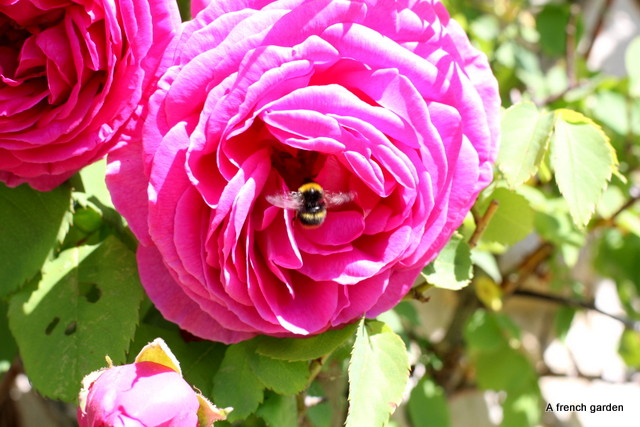
The early bumble bees have claimed this rose as theirs.
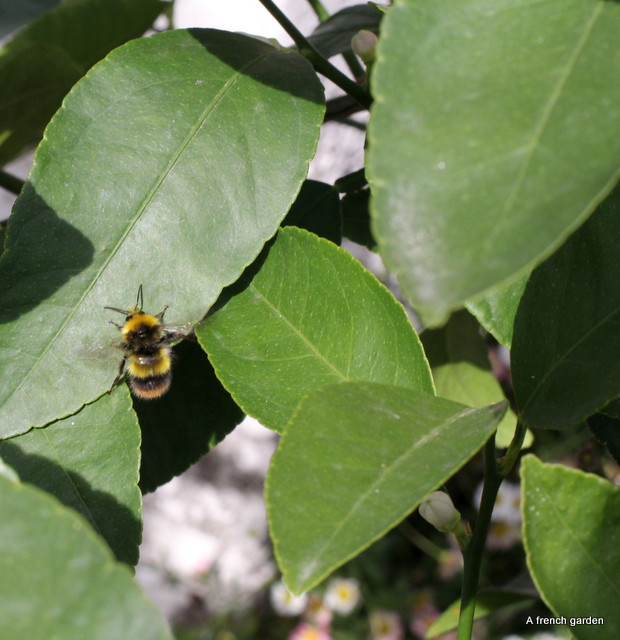
The male early bumble bees have started to appear. They will be looking for the new queens so their cycle will soon be finishing. I will miss them, they are so quick and lively. I will have to wait until next spring until the new queens appear and start their own nests.
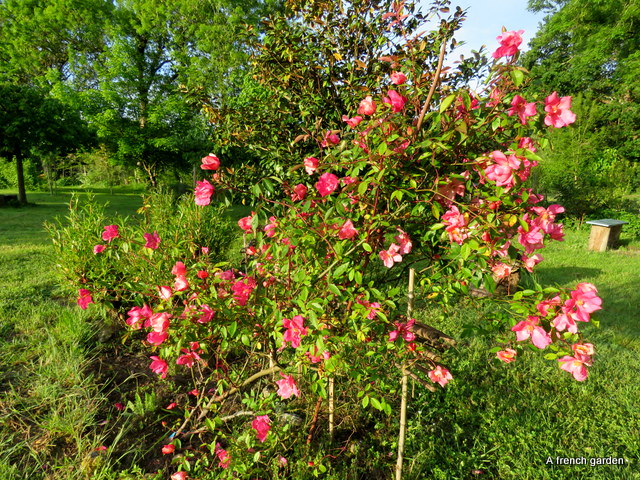
My Rosa Mutabilis is making a bid for freedom. I planted her too close to the willows, which were cut short at the end of March, and now she is trying to escape from them before they shade her again. The willows will win the race so I must really find a better place for her in the autumn.

The colour of this rose changes as the flower matures.

Of course, the best feature is that the bees love the rose pollen.

It’s amazing how my view point of plants can change. I was given some Knipofia or red hot pokers but never really liked them and I removed most of them. Kourosh saved this one. It is in a very poor position but it attracts a lot of honeybees. It must have a lot of nectar as they stay inside the flower a long time and I often see two or three bees on the same flower.
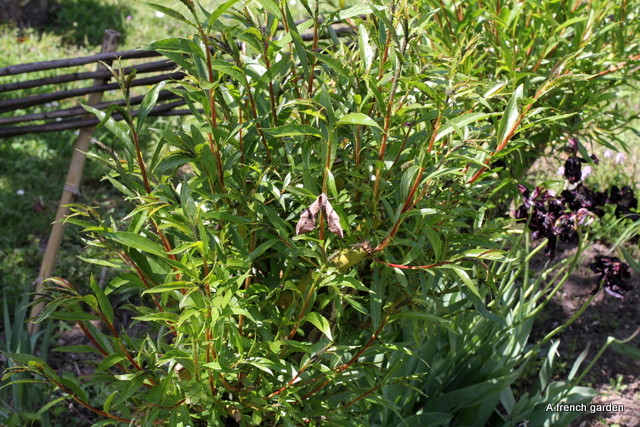
It is not only bees that we notice. The “dead leaf” on the young willow shoots looked a very unusual shape – for a willow leaf.
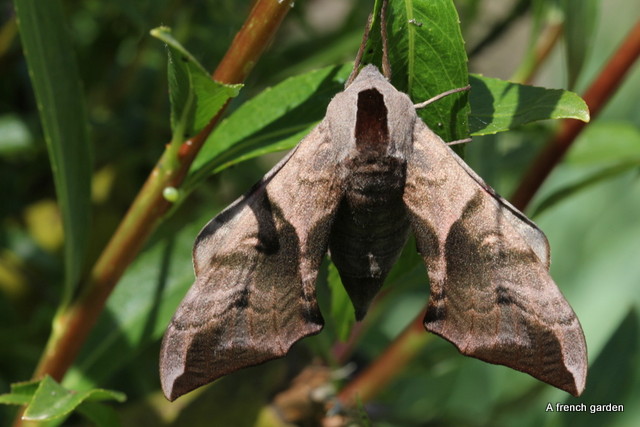
A closer look showed us a beautiful moth, Smerinthus ocellata, the Eyed Hawk Moth, I think. It looks so clear in a photograph but the resemblance to a dead leaf is uncanny in the light of day.

The bees are omnipresent in our lives at the moment. Our neighbour opposite has a laurel hedge and I had warned her to tell me if she saw any strange insects flying near it because Asian hornets often nest low in hedges for their first small nest. Two days ago she came to see me because of the flying insects and the noise of buzzing in the hedge. I immediately got on my bee suit as the laurel was not in flower so I presumed a swarm had landed in the hedge.
She was quite right. There was a lot of noise and it was honey bees! I searched all through the hedge, it was empty in places, but there was no swarm and the noise was not in the one area but all over.
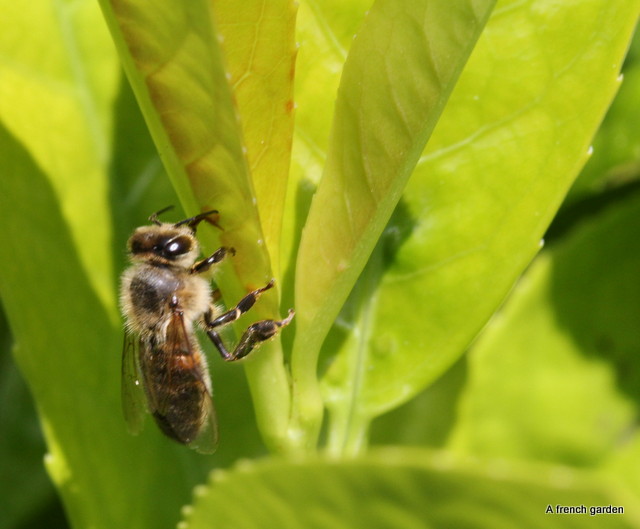
Then we noticed that the bees were all doing the same thing. They were on the underside of the very young shoots and lapping up the surface exudate.
The laurel is known as Laurier palme here. I checked on it and its latin name is Prunus laurocerasus. The leaves are actually toxic if you were to choose to chop up the leaves and make cherry-laurel water. However, small doses of this water has been used in the past to give an almond flavour to pastries and sauces. Traditional medicines have used the cherry-laurel as an anti-spasmodic and sedative and to treat coughs. It contains hydrocyanic acid and I can think of better things to flavour my sauces with.
However, the bees want it. Could it be an ingredient of propolis? Propolis is what the bees use to fill any holes in their hives and has antiseptic, antibacterial and antioxydant properties.

The bees are omnipresent. They tax our ingenuity by swarming in tall Hawthorn trees but Kourosh has improvised with very long stick and a plastic bucket secured with packaging tape. I did not think it would work – but it did. We are at swarm number seven now. It has been a busy time for the bees.
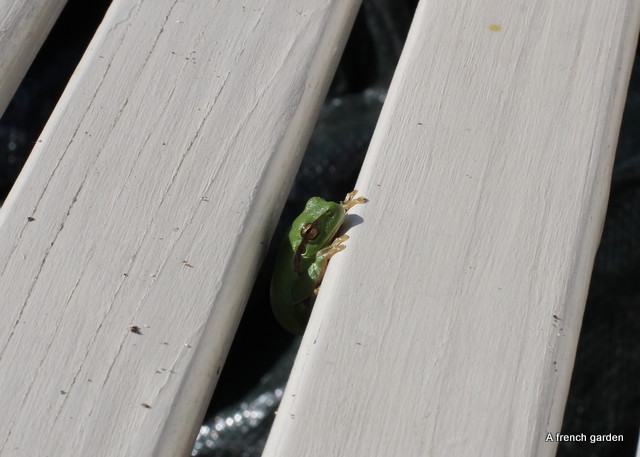
At the moment I look forward to a quieter life, like that of our little tree frog that sleeps under the plastic cover of our outdoor table. He only wakes up when we lift of the cover to have our morning coffee.

Love the moth and frog. I see the tiny green frogs here near Carpentras on and off. We also have those busy male bees. They hung out at my bee house waiting for the females to hatch, but have gone now.
bonnie
LikeLiked by 1 person
The little green frogs turn up in the strangest of places, often sunbathing in the garden. I do not think it would be bumble bees in your bee house but the solitary bees called Osmia, probably Osmia cornuta. My Osmia cornuta have finished but left lots of filled tubes in the bee house to hatch next spring. Amelia
LikeLiked by 2 people
Of course they are Osmia! They look a bit like your photo which mixed me up. Osmia = bumblebee, no. I read somewhere that the green frogs secrete some kind of a barrier so they don’t dry out. I had them at my house in the Herault and they would sit on leaves in the sun in the very hot weather, and I would mist them occasionally. Afterwards I found out they probably didn’t need misting ….
bonnie
LikeLiked by 1 person
Natural suntan lotion? I could do with some of that.
LikeLike
Hello Amelia,
What a fabulous late spring post – wonderful flowers – really envious of the mutabilis, fascinating about the bees and the laurel exudate, and as for swarm seven and Khourosh’s bucket method of capture from a height – brilliant. On a practical point, and maybe for future personal reference, I’m intrigued how he managed – presumably after thrusting the bucket against the swarm holding branch – to get the branch down to the ground without the bees spilling out – probably a very silly question, but hope you see what I’m getting at! Are the swarms all ending up being relocated elsewhere?
Best wishes and envy you the obvious warmth we had minus 6 here 2 nights ago.
best wishes
Julian
LikeLiked by 1 person
Kourosh very carefully positioned the bucket underneath and around the swarm then loosened it with a pumping motion. That dislodged the bunch and they tumbled into the bucket. The bees are then poured into their new home. Frames are added and they are left until nightfall so that stragglers can be reunited. We are giving them to friends except for “to morro” (we found her in a hedge while out walking) which if all goes well will replace a hive that did not requeen after we divided it. Amelia
LikeLiked by 1 person
Thanks Amelia – really interesting – I’m guessing you’ll be getting viewed as the swarm gatherers, in your area, Have you found swarms you’ve collected noticeably healthier/ calmer, or the opposites, to your other hives, or were most acquired as swarms originally anyway?
best wishes
Julian
LikeLike
Each hive has its personality and we have never had bees from a professional breeder. We can’t compare with bees bred as Buckfast or Italian or anything special. If I had my choice I would try and breed black bees but we would need to use an isolated drone apiary for that.
LikeLike
The bees are finding extra floral nectaries on the laurel, some plants have these as an extra source of nectar even when the plant is not flowering. One theory is that they are used to reward ants, which then protect the plant from predators- https://adventuresinbeeland.com/2014/11/06/4th-honey-bee-products-and-forage-revision-post-the-location-and-function-of-the-extra-floral-nectaries-of-broad-bean-cherry-laurel-cherry-and-plum/
I just love that rose climbing up your house, it is perfect. And how ingenious of Kourosh to make the swarm catcher. I could do with one of those too right now!
LikeLiked by 1 person
Thank you for the link. I remember reading the post but before we had our own bees. I can confirm that the laurel nectaries are very hard to see although I have noticed them on broad bean leaves. I love the noise the bumble bees make once they get into the middle of the rose! Amelia
LikeLike
The sound of summer 🙂
LikeLiked by 1 person
I have Rosa mutabilis, it’s a real beauty. I read Le Dauphiné on line and I was amazed to read that three horses were killed by ‘Les Abeilles tueues’ in the region of the Rhone yesterday. I didn’t know we have Killer Africanised honey bees in Europe, or do you think they were Asian hornets?
LikeLiked by 1 person
It sounds very strange, I checked the story – poor horses! People should be able to tell the difference between bees and hornets, I suppose they saw dead bees. Usually both the bees and hornets would only “attack” if their nests were threatened. Even with the hornets problems arise when, for example, someone goes through a nest with a strimmer. It is very unusual for any insects to attack on this scale unprovoked. I don’t think beekeeping here could survive an additional blow like Africanised bees being introduced. Amelia
LikeLike
I loved your pictures. Great post.
LikeLiked by 1 person
Thank you, I enjoy capturing the garden but especially I enjoy taking pictures of the bees. Amelia
LikeLike
I wondered whether there were aphids on the laurel and the bees were taking the sweet liquid they excrete.
LikeLiked by 1 person
No aphids. There are still great numbers of the bees on the young shoots. As Emily explains above there are special plant nectaries and these are situated in Laurel exactly where I observe the bees lapping up the exudate. The bees look for more than sugar for food. They need the basic materials that will help them make the propolis and the wax. Amelia
LikeLiked by 1 person
Well Amelia, I am envious of your roses, they are deer food here, and I just stopped trying to grow them. My solitary mason bees have hatched well after a winter as cocoons in the refrigerator, a good mix of males and females and the girls are filling up the bee tubes like there was no tomorrow. The porch has a permanent hum. Apple trees have blossom so things are aligned after a very long cold winter. My babies will be done in a week or so. But this year I also have a few leafcutter cocoons from the wild, truly beautiful to look at. I do not know the Latin names, hoping they will also emerge and do their thing later in the summer.
LikeLiked by 1 person
You have got some pretty scary beasts over your side (thinking of the bears) and anything that can eat roses has my respect.
I love the leafcutters too. Usually they use leaves to block up their holes but one year one finished with a pink rose petal. So pretty!
LikeLike
How wonderful is nature’s camouflage.
LikeLiked by 1 person
It is and is much more “real” when seen by the human eye than by a camera lens. Amelia
LikeLiked by 1 person
Marvellous observations Amelia. I never realized hawk moths camouflage as dead leaves during the day. I assumed they rested against tree barks. But your photo clearly shows it. If I were a bird, I would fly past without a second look! I read that they use apples as a host plant (in addition to sallows and willows), so this summer you may find some of their beautiful caterpillars on your trees. And I’m very jealous of your garden tree frogs.
LikeLiked by 1 person
The caterpillars will have plenty of choice here as there are plenty of willows and apple trees for them to choose from. The moth, if it was the same one, changed its perch and sat on the end of a cut log near a bee hive. It was really a thin cut branch but it perched on the end of it for a few days. I suppose this means it flew at night and came back to the same perch in the evening. Amelia
LikeLike
Seven swarms! Oh my! One is a concern. Two sort of makes one wonder. The third is a problem! We had three hives in one building. The beekeeper who took them could not explain why. Two more tried to move in where two hives were removed! It is only in the building, but no other. My colleague in Los Angeles, who happens to be afraid of bees, had a few swarms move into his garden over the years, but I sort of think that it is because it is because they like all the vegetation there.
LikeLiked by 1 person
I agree that it is the availability of food and lodging that attracts the bees. David Cushman, who is now deceased, but was a very well respected authority on bees in the U.K. thought it was Ley lines. Interesting. Amelia
LikeLiked by 1 person
That is compelling. I am certainly no entomologist, but while doing my internship in the Santa Clara Valley, I noticed something odd about the many Monterey pines we removed during that summer. (Monterey pines were popular in the 1950, but not so much before or after, so most were in about the same age range, and therefore dying at the same time.) In the summer of 1988, MANY Monterey pines were deteriorating and needed to be removed. As they deteriorated, they became infested with a variety of insects, particularly the Western pine bark beetle. Trees that were well structured and formerly healthy were most likely to succumb quickly. However, the most disfigured trees that should have been distressed and appealing to the insects seemed to be more resilient. I noticed that they were disfigured because they had been pruned for clearance from electrical cables above. One of my colleagues, who is not an entomologist either, mentioned that the beetles might be repelled by an electromagnetic field generated by the utility cables. We really did not know. Other insects, particularly carpenter ants, seem to be attracted to fuse boxes.
LikeLiked by 1 person
Very interesting! A lot of work has been done with bees and it has been shown that they use the earth’s geomagnetic field for orientation purposes and that they can sense the weak electric field emitted by negatively charged flowers. It would seem very possible that other insects would be sensitive to electric fields around power cables.
LikeLiked by 1 person
Maybe that is why bug zappers are no longer in use.
LikeLike
tee hee
LikeLiked by 1 person
Fascinating story about cherry-laurel water, it was a new one to me.
You mentioned red hot pokers, when I was growing up they seemed very fashionable in UK gardens but I rarely see them nowadays.
LikeLike
I’m working on the laurel to see if it could be used to deter ants from near the bee hives. It is a bit inconclusive at the moment. You are right about red hot pokers being fashionable, I had forgotten about that. I think I found them too stark and gaudy. It is amazing how the bees can make me review my opinions 🙂 Amelia
LikeLike
I saw Rosa mutability being grown as a climber against a warm wall for the first time last week. It was massive!
LikeLiked by 1 person
Ours is still quite small. A big climber must put on quite a show. Amelia
LikeLiked by 1 person
It was colourful – a little bit spindly, but lovely for all that.
LikeLike